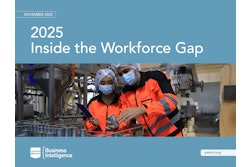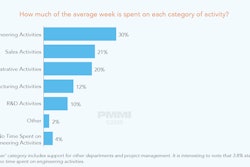In the heart of Pennsylvania lies the Hershey Company, which has been synonymous with confectionery delight for over a century. In late September, it was also home to PMMI's 2024 Annual Meeting, "Where Operations and Solutions Convene," hosted by JLS Automation. While the highlight of the event was an exclusive tour of JLS's state-of-the-art production facility in York, Pa., the meeting also featured a robust educational program that Tim Hinegardner, vice president of manufacturing, at the Hershey Company, kicked off with a presentation on the company's past and present and how the 125-year-old company has embraced technology.
Founded by Milton Hershey, an entrepreneur who transformed a vision into a legacy, the company has grown from a small caramel business to a global chocolate powerhouse. Yet, as the world changes, so too must Hershey. The company now finds itself at a crossroads, balancing its storied past with the demands of modern manufacturing and digital innovation.
Milton Hershey's journey was one of resilience and foresight. After several failed ventures, he struck gold with chocolate, a luxury item at the time. His vision was to make chocolate accessible to the masses, a dream he realized by building a factory in what was then farmland in Hershey, Pennsylvania. He didn't just build a factory; he built a community, complete with recreational and educational facilities for his employees. This commitment to social responsibility continues to be a cornerstone of Hershey's ethos.
Today, Hershey's supply chain is a marvel of modern engineering, encompassing over 950 ingredient and packaging suppliers, 21 manufacturing plants, and a network of co-manufacturers and co-packers. The company's largest plant in West Hershey produces over 500 million pounds of finished goods annually.
The pandemic underscored the need for agility and resilience in supply chains. Hershey's response was to accelerate its Supply Chain 2.0 initiative, which focuses on technology and capacity additions. This initiative began just before the pandemic and has evolved through multiple phases, driven by the increasing demand for Hershey's products.
One of the most significant shifts in Hershey's strategy is its embrace of digital technology. The company has invested heavily in automation, artificial intelligence (AI), and digital tools to enhance its manufacturing capabilities. Automated Guided Vehicles (AGVs) and Autonomous Mobile Robots (AMRs) are now familiar sights in Hershey's facilities, reducing changeover times and increasing operational flexibility. These technologies are not just about efficiency but about creating a more adaptable and resilient manufacturing environment.
Hershey's digital journey is also about data. The company is digitizing its LEAN processes, from centerline checks to defect handling, and integrating these with its Enterprise Resource Planning (ERP) system. This digital backbone supports AI-driven decision-making, enabling plant managers and supervisors to focus on the most critical daily issues. For instance, real-time data on fat variation in chocolate production can now be used to optimize processes, reducing waste and improving quality.
Yet, technology is only part of the equation. Hershey's commitment to its people remains unwavering. The company has implemented flexible work schedules, job rotation, and continuous training programs to enhance employee engagement and retention. During the pandemic, Hershey recognized the importance of reducing overtime and increasing compensation to remain competitive. These efforts have paid off, with attrition rates dropping significantly.
Hershey's focus on social responsibility extends beyond its employees. The company is deeply involved in supporting cocoa-growing communities and investing in education and infrastructure to improve living conditions. This commitment is mirrored in Hershey's sustainability initiatives, prioritizing packaging reduction, reuse, and recycling. The company also adapts to changing consumer preferences, offering more variety and customization in its product offerings.
As Hershey navigates these complexities, it remains anchored by its core values: People First, Quality, Safety, Service, Sustainability, and Value. These values guide every decision, from sourcing ingredients to investing in new technologies. The company's ability to balance tradition with innovation is a testament to its resilience and foresight.
Looking ahead, Hershey continues to explore new growth opportunities, both domestically and internationally. Strategic acquisitions and investments in emerging markets support its vision of becoming a leading snacking powerhouse.






















